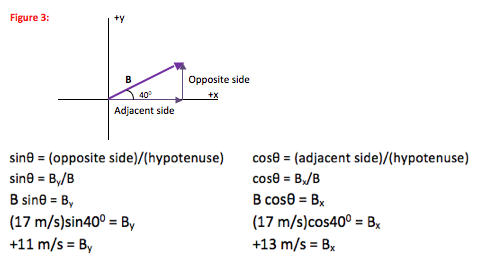What are the x- and y-components of the following vectors? The magnitude of vector A is 8.0 m/s and the magnitude of vector B is 17 m/s.

-
In this problem, you are asked to find the components of a vector. You aren’t doing any physics in this problem; it is practice for a mathematical step that you will use in future physics problems which involve vector quantities.
-

The most visual way to see vector components is to draw a right triangle with the vector as the hypotenuse and the sides of the triangle enclosing the given angle.
You can also find vector components by using the angle measured counter-clockwise from the +x axis. In that case, the x-component will always correspond to cosθ and the y-component to sinθ. I chose to show it this way because it is easier to visualize the vector components and get a good feel for what the process does.
-

The reason we pick a coordinate system with perpendicular axes is so that we can use definitions based on right triangles. For a right triangle:
Sinθ = (opposite side)/(hypotenuse)
Cosθ = (adjacent side)/(hypotenuse)
Tanθ = (opposite side)/(adjacent side)
These relations are often remembered as soh-cah-toa. In this case, you know the vector (the hypotenuse) and want to find the opposite and adjacent sides, so will use the sin and cos relations. -
Step 1

There is no further calculation required for Vector A. Scroll down to step 2 to find the components of Vector B.
-----------------------------------------------------------------------------------------
Step 2

There is no further calculation required for Vector B and no other information requested in this problem.
The x-component of Vector A is opposite to the 15o angle. When finding components by drawing a right triangle around the given angle, you need to put in the signs explicitly. In this case, the x-component points to the left and so is negative.
The y-component of Vector A is adjacent to the 15o angle. When finding components by drawing a right triangle around the given angle, you need to put in the signs explicitly. In this case, the y-component points up and so is positive.
The y-component of Vector B is opposite to the 40o angle. When finding components by drawing a right triangle around the given angle, you need to put in the signs explicitly. In this case, the y-component points up and so is positive.
The x-component of Vector B is adjacent to the 40o angle. When finding components by drawing a right triangle around the given angle, you need to put in the signs explicitly. In this case, the x-component points to the right and so is positive.
Doesn’t the x-component always go with cosθ?
No. The x-component of a vector can be either sinθ or cosθ, depending on which angle you are given. Cosθ always goes with the side of a right triangle that is adjacent to (touches) the given angle.
How do you determine signs of the components?
You can do this visually from your drawing. A y-component that goes up is positive; one that goes down is negative on the coordinate system chosen here. Likewise, for this coordinate system an x-component to the right is positive and one to the left is negative.
My instructor taught me to always use an angle measured from the +x axis. Why did you use an angle measured from the y-axis?
You can also find vector components by using the angle measured counter-clockwise from the +x axis. In that case, the x-component will always correspond to cosθ and the y-component to sinθ. I chose to show it this way because it is easier to visualize the vector components and get a good feel for what the process does.
Where did the negative sign on Ax come from?
The x-component of Vector A is opposite to the 15o angle. When finding components by drawing a right triangle around the given angle, you need to put in the signs explicitly. In this case, the x-component points to the left and so is negative.
-

This problem asked you only to practice the math of dividing vectors into components. A good double check is that no component is greater than the length of the vector, and that the shorter component is less than the longer one. It is also a good idea to go back to the picture to make sure that you correctly assigned signs to each component.
Note that when you replace a vector with its components you have the same physical effect as for the original vector. So, in this case, driving at a 40o angle north of east for say one hour at 17 m/s would have the same effect as driving east for one hour with a speed of 13 m/s and north for one hour with a speed of 11 m/s.
